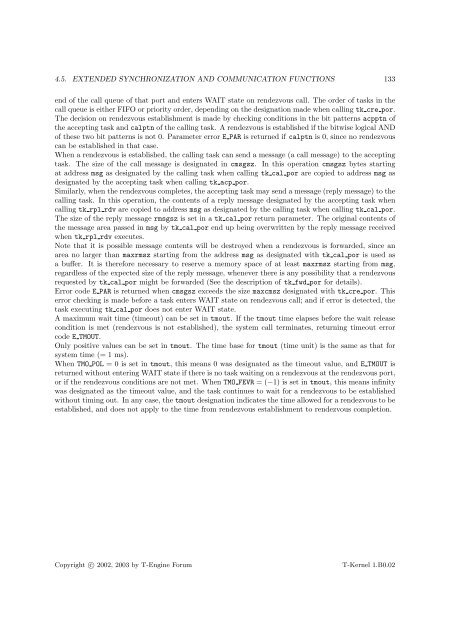T-Kernel Specification (1.B0.02)
T-Kernel Specification (1.B0.02)
T-Kernel Specification (1.B0.02)
Create successful ePaper yourself
Turn your PDF publications into a flip-book with our unique Google optimized e-Paper software.
4.5. EXTENDED SYNCHRONIZATION AND COMMUNICATION FUNCTIONS 133<br />
end of the call queue of that port and enters WAIT state on rendezvous call. The order of tasks in the<br />
call queue is either FIFO or priority order, depending on the designation made when calling tk cre por.<br />
The decision on rendezvous establishment is made by checking conditions in the bit patterns acpptn of<br />
the accepting task and calptn of the calling task. A rendezvous is established if the bitwise logical AND<br />
of these two bit patterns is not 0. Parameter error E PAR is returned if calptn is 0, since no rendezvous<br />
can be established in that case.<br />
When a rendezvous is established, the calling task can send a message (a call message) to the accepting<br />
task. The size of the call message is designated in cmsgsz. In this operation cmsgsz bytes starting<br />
at address msg as designated by the calling task when calling tk cal por are copied to address msg as<br />
designated by the accepting task when calling tk acp por.<br />
Similarly, when the rendezvous completes, the accepting task may send a message (reply message) to the<br />
calling task. In this operation, the contents of a reply message designated by the accepting task when<br />
calling tk rpl rdv are copied to address msg as designated by the calling task when calling tk cal por.<br />
The size of the reply message rmsgsz is set in a tk cal por return parameter. The original contents of<br />
the message area passed in msg by tk cal por end up being overwritten by the reply message received<br />
when tk rpl rdv executes.<br />
Note that it is possible message contents will be destroyed when a rendezvous is forwarded, since an<br />
area no larger than maxrmsz starting from the address msg as designated with tk cal por is used as<br />
a buffer. It is therefore necessary to reserve a memory space of at least maxrmsz starting from msg,<br />
regardless of the expected size of the reply message, whenever there is any possibility that a rendezvous<br />
requested by tk cal por might be forwarded (See the description of tk fwd por for details).<br />
Error code E PAR is returned when cmsgsz exceeds the size maxcmsz designated with tk cre por. This<br />
error checking is made before a task enters WAIT state on rendezvous call; and if error is detected, the<br />
task executing tk cal por does not enter WAIT state.<br />
A maximum wait time (timeout) can be set in tmout. If the tmout time elapses before the wait release<br />
condition is met (rendezvous is not established), the system call terminates, returning timeout error<br />
code E TMOUT.<br />
Only positive values can be set in tmout. The time base for tmout (time unit) is the same as that for<br />
system time (= 1 ms).<br />
When TMO POL = 0 is set in tmout, this means 0 was designated as the timeout value, and E TMOUT is<br />
returned without entering WAIT state if there is no task waiting on a rendezvous at the rendezvous port,<br />
or if the rendezvous conditions are not met. When TMO FEVR = (−1) is set in tmout, this means infinity<br />
was designated as the timeout value, and the task continues to wait for a rendezvous to be established<br />
without timing out. In any case, the tmout designation indicates the time allowed for a rendezvous to be<br />
established, and does not apply to the time from rendezvous establishment to rendezvous completion.<br />
Copyright c○ 2002, 2003 by T-Engine Forum<br />
T-<strong>Kernel</strong> <strong>1.B0.02</strong>












![[8] 2002 e-business-strategies-for-virtual-organizations](https://img.yumpu.com/8167654/1/190x257/8-2002-e-business-strategies-for-virtual-organizations.jpg?quality=85)


